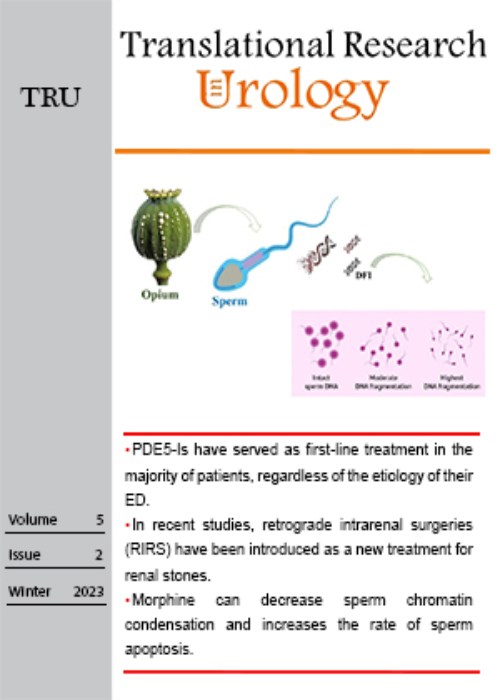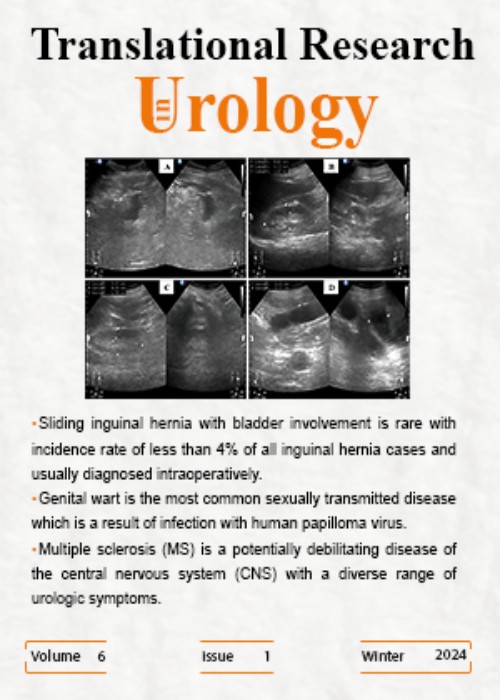فهرست مطالب

Journal of Translational Research in Urology
Volume:5 Issue: 2, Spring 2023
- تاریخ انتشار: 1402/03/03
- تعداد عناوین: 8
-
-
Pages 59-62
Differentiation and migration of spermatogonial stem cells (SSCs) from the basal to the adluminal compartment of the seminiferous tubules require a well-specialised scaffold created by a well-developed cytoskeleton in the large cytoplasm of the Sertoli cells. The connection between these scaffolds in two adjacent Sertoli cells and germ cells is provided by adherent junctions. The formation of such a regularly- fabricated scaffold and complex network of intercellular communication is disrupted in the absence of testosterone. In an androgen-free microenvironment, Sertoli cells probably undergo the epithelial-mesenchymal transition (EMT) process. The EMT in the Sertoli cells can be explained by the same mechanisms by which convert prostate cancer epithelial cells) positive for androgen receptor), treated with an androgen deprivation therapy (ADT), to mesenchymal cells. The potential of the plasticity and reprogramming of Sertoli cells could open a new window for basic and clinical studies, especially in assisted reproductive studies such as the approaches of the in vitro spermatogenesis or testicular tissue xenograft.
Keywords: testosterone, Sertoli Cells, Sertoli Cell Maturation, epithelial-mesenchymal transition, androgen deprivation -
Pages 63-65Introduction
The Calyceal diverticulum represents less than 0.5 % of the general population. The incidence of calculi in the calyceal diverticula is between 10 to 50 %. In recent studies, retrograde intrarenal surgeries (RIRS) have been introduced to treat renal stones. We present a case of lower pole stone in a calyceal diverticulum that was refractory to shock wave lithotripsy (SWL) and underwent flexible Ureterorenoscopy (f-URS) with holmium laser lithotripsy.
Case presentationA 48-year-old female with a previous history of renal stones presented to our clinic with a 14mm left lower pole renal stone and calyceal diverticulum. She had a history of SWL failure and a history of right nephrectomy in childhood, so the patient chose to undergo RIRS due to the potential risk of bleeding during the PCNL procedure in a single kidney. An 11/13 Fr ureteral access sheath, an 8.7 Fr flexible ureteroscope, and the holmium laser with 200 µm fiber laser for incising the diverticular neck and dusting lithotripsy pulverizing the stone fragments less than 2 mm were applied to the patient. The patient was discharged postoperative day two without any complications. In the follow-up, the patient was asymptomatic, and imaging at three months revealed stone-free status.
ConclusionFlexible ureteroscopy with holmium laser lithotripsy is a viable option for managing stones in calyceal diverticula, especially in single kidney and high-risk patients for bleeding during PCNL.
Keywords: calyceal diverticulum, Nephrolithiasis, Retrograde Intrarenal Surgery, Holmium laser -
Pages 66-73
Addiction to opium and illicit substances has become a significant issue that must be dealt with because limitless complications can arise from their misusage. It’s impossible to deny the significance of those. The relationship between OS (Oxidative stress), which eventually leads to DNA fragmentation and illicit substance addiction has been suspected, and there have been many attempts to prove it. Infertility involves many couples globally, and several causes are attributed to it. However, the reasons for many of these cases remain unknown. We investigated the review studies on the relationship between illicit substances and infertility. Surprisingly, the odds of fertility decrease in individuals who administrate illegal substances. Many studies have illuminated that in addition to hormonal modulation levels and pathological changes, DNA fragmentation should be considered as a cause of infertility. However, most studies were animal studies, and there is a lack of evidence in clinical studies. Antioxidants can be used as the first-choice treatment in patients with unknown causes of infertility. The outcomes of antioxidants in animal studies were satisfactory; however, against all the odds, the results in clinical studies were not as good.
Keywords: Substance Use, DNA Fragmentation, Infertility, Opium -
Pages 74-77IntroductionTo compare the efficacy of paraurethral BoNT-A injection and a combination of muscle relaxant and alpha-blocker medication in patients with supra-sacral spinal cord injury (SCI) and detrusor sphincter dyssynergia (DSD), as measured by maximum urinary flow rate (Qmax).MethodsThis was a randomized, controlled trial conducted over 6 months. Patients with suprasacral SCI and DSD were randomly assigned to two groups. Group 1 received intradetrusor BoNT-A injection with a combination of muscle relaxant and alpha-blocker medication, while Group 2 received concomitant intradetrusor and paraurethral BoNT-A injection. The primary outcome measure was maximum urinary flow rate (Qmax), assessed at baseline and after 6 months of treatment.ResultsThis study had 35 patients. At baseline, the mean Qmax in Group 1 was 12.6 ml/s, while in Group 2 it was 13.2 ml/s. After 6 months of treatment, the mean Qmax in Group 1 increased to 16.5ml/s, while in Group 2 it increased to 19.8ml/s (P-value<0.05).ConclusionThis study suggests that both paraurethral BoNT-A injection and a combination of muscle relaxant and alpha-blocker medication are effective in improving Qmax in patients with suprasacral SCI and DSD. However, paraurethral BoNT-A injection appears to be more effective than the combination of medications in improving Qmax. More research with larger sample sizes are required to prove these findings.Keywords: injection, Combination therapy, Alpha-blocker
-
Pages 78-83IntroductionHuman metastatic breast adenocarcinoma is one of the most diagnosed cancers in females which can metastasize to other organs such as kidneys. So, we investigated the possible renal parenchymal changes in nude mice due to induced metastatic breast adenocarcinoma.Methods8 female mice were randomized into 2 groups. MDA-MB-231 subtype was injected in their left flank in the second group. Weight and tumor size were measured weekly. After euthanasia, tumoral and renal tissues were assessed by a pathologist.ResultsThe mean weight of the removed tumors was 2.04 grams (±0.05). Also, the mean weight of kidneys in G1 was 2.8±0.07 grams, and in G2 was 2.71±0.09 grams (P-value<0.05). Histopathological sections of renal parenchyma demonstrate normal and injured structures of the kidney tissue in groups 1 and 2, respectively. The thin arrow indicates the edema and the arrow head shows the hyperemia.ConclusionThere seems to be no statistically meaningful difference in renal changes and weight gain between normal and xenograft groups, but every 4 weeks’ measures show the tumor group a bit higher. There was no difference in metastasis pattern in both groups.Keywords: Metastatic breast cancer, Renal, MDA-MB-231, BALB, c Nude Mice
-
Pages 84-88IntroductionVaricocele is defined as dilated and tortuous veins in the pampiniform network. This study aims to compare somatometric indices in patients with grade III varicocele with non-varicocele patients.MethodsThis case-control study was conducted on patients referred to the Urology Department and Clinic of Razi Medical Education Center in Rasht. The subjects of the case group were patients with grade III varicocele. The control group was other patients referred to the clinic and urology department, in whom varicocele was not diagnosed. All subjects were evaluated in terms of gynecomastia, BMI, height, weight, penis length, waist circumference (WC), waist-to-hip ratio (WHR), as well as varicose leg disease and inguinal hernia and its relationship with grade III varicocele.ResultsIn this study, 192 patients were compared in two groups of patients with gradeⅢ varicocele (n=96) and non-varicocele patients (n=96). There was a significant difference in the mean height between the two groups (P-value=0.001). But there was no statistically significant difference in the BMI (P-value=0.856), waist-to-hip circumference (P-value=0.117), and waist circumference (P-value=0.363) in the two studied groups. On the other hand, the average length of the penis in afflicted subjects was significantly upper (P-value=0.041) and gynecomastia was more prevalent in this group (P-value=0.008)ConclusionThe results of the present study showed that patients with grade III varicocele are significantly taller and have significantly longer penis lengths and a higher incidence of gynecomastia than those without this disease.Keywords: Varicocele, penis, Gynecomastia
-
Pages 89-94IntroductionSARS-CoV-2, also known as COVID-19, emerged in China in December 2019. SARS-CoV-2 viruses use angiotensin-converting enzyme 2 (ACE2) as a receptor to enter cells. Studies have indicated that SARS-CoV-2 has destructive impacts on spermatogenesis and semen parameters, including sperm count, sperm motility, and sperm morphology. In addition, there is a concern regarding the negative consequences of treatment of COVID-19 with Remdesivir on infertility status. We aimed to investigate the effects of Remdesivir and also COVID-19 on semen parameters in patients with confirmed infertility.MethodsThe present study included 90 patients aged between 23 to 51 years referring to our hospital between March 2021 and July 2022. All of the patients were diagnosed with primary or secondary infertility, which was confirmed by semen analysis, and also diagnosed with active COVID-19 by reverse transcription polymerase chain reaction (RT-PCR) tests. All patients underwent semen analysis four months after the recovery from COVID-19. Patients who had severe manifestations of COVID-19 received intravenous Remdesivir.ResultsThe mean age of the study participants was 35.72±6.29 years. Twenty-one patients received Remdesivir for the treatment of COVID-19. The semen parameters, including sperm count, sperm motility, and sperm morphology, were analyzed before and after the development of COVID-19. Our analyses revealed a significant decrease in sperm count, sperm motility, and sperm morphology after the development of COVID-19 compared to the semen analysis results in the pre-disease period (P-value=0.000). We also showed that Remdesivir has a statistically insignificant effect on semen parameters with the P-value of 0.511, 0.408, and 0.940 for sperm count, sperm motility, and sperm morphology, respectively.ConclusionAlthough COVID-19 has negative consequences on semen parameters, Remdesivir can be considered a safe medication for the course of the disease.Keywords: Infertility, SARS-CoV-2, COVID-19, Semen Analysis
-
Pages 95-101IntroductionADPKD, a genetic ailment, leads to the emergence of tiny sacs brimming with fluid, commonly known as cysts, within the kidneys which has an association with Renal Cell Carcinoma (RCC). We explore the gene signature shared between ADPKD and RCC based on integrated network analysis.MethodsWe searched the DisGeNET database to extract the overlapped genes (until November 2023) across the dominant autosomal disorder characterized by the growth of multiple cysts in the kidneys and all types of kidney cancers. Further, Enrichr was utilized for the identification of significant Gene ontology (GO) terms in the Kyoto Encyclopedia of Genes and Genome (KEGG) pathway. Further, the highest linkage hub genes were determined across the selected disorders through the protein-protein interaction (PPI) network construction for the overlapping genes using cytoHubba.ResultsWe identified 187 common genes between ADPKD and urologic disorders. We identified 5 hub genes retrieved via Enrichr and Cytohubba analysis including TNF, JAK2, TGFB1, IL6, and EPO. These genes were mostly involved in molecular pathways and the KEGG pathway. The overlapping genes were most significantly related to the regulation of cell population proliferation (GO:0042127), pathways in cancer, pancreatic cancer, and receptor-ligand activity.Conclusionfrom a total number of 187 common genes, 5 key genes were mutual across ADPKD and all types of renal carcinoma. The identified feature could be potential targets in both disorders, even to manage malignancies in polycystic kidney disease.Keywords: Autosomal dominant polycystic kidney disease, Urological Disorders, Single Nucleotide Polymorphisms, genes, Molecular Pathways


